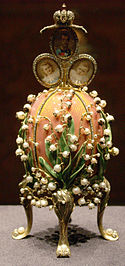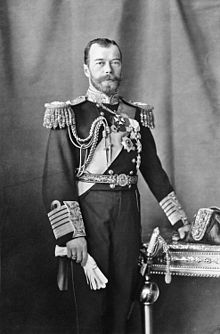The Faberge Eggs are probably best-known for their association with Czar Nicholas II and Alexandra, the ill-fated heads of the Russia who were deposed and eventually murdered during the Russian Revolution in 1918. Like his father before him, Nicholas commissioned a new egg annually, as a present for his wife. Fortunate spacing, since the eggs often took up to a year to make.
When the palaces were looted, the eggs, along with other treasures, were crated up and stored. (No doubt, for "safekeeping.") Some disappeared then, others were surreptiously taken when their owners escaped. A number were sold at bargain basement prices in the 1930s, when Stalin realized they could help fund the Bolshevik cause. One of the chief salesmen also became a major collector: Armand Hammer.
The Faberge eggs continue to be sought-after...but now their worth has skyrocketed to millions (actually tens of millions) of dollars. Not only are they valuable in terms of materials -- they're made of gold and other precious materials, decorated with jewels, pearls and such -- but these tiny pieces retain a enigmatic link to their historical past.
Now another Faberge egg has turned up -- but in a strange way. Its owner bought the egg for the gold's scrap value -- about $500 then. The poor guy paid $14,000 for the piece, was sure he'd made a huge mistake, and was desperate to sell it. When he couldn't, he did some research, and practically fainted when he realized what he had:
The third Imperial Faberge Easter Egg.
The egg was Tsar Alexander III’s 1887 Easter gift to his wife, Tsarina Maria Feodorovna. The 3.2-inch egg is on an elaborate gold stand supported by lion paw feet with three sapphires, with golden garlands surrounding it.
| I'll buy it! I'll buy it! |
A diamond acts an opening mechanism to reveal the Vacheron Constantin watch inside.
The egg is seen here in a 1905 photo: focus on the boxed section.
Estimated value: $33 million. (Learn more about this fabulous piece here.)
Seven eggs still remain lost. A few have been glimpsed here and there in the recent past, mostly at locations in the U.S. Find one, and you could practically name your price: that's how rare these are.
Learn more about the existing Faberge eggs, so you know what to look for. Forty-two can be found in collections around the world. (At least 20 of those eggs belong to Russians. Go figure.) Two more are known of, but it's uncertain whether they still exist.
 | ||
| One of my favorites - the 1898 Lilies-of-the-Valley egg |




1 comment:
You broadened my horizons with the history of the eggs. My favorite is your favorite. So delicate and feminine!
Post a Comment